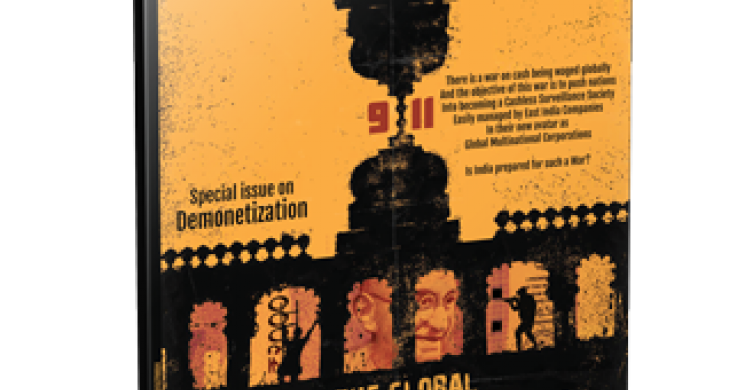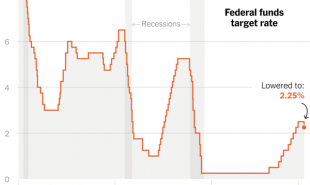
The Global War On Cash: Target India - Part 1
via Shelley Kasli and greatgameindia.com India's only quarterly journal on Geopolitics & International Affairs.
The big bankers of the world, who practice the terrorism of money, are more powerful than kings and field marshals, even more than the Pope of Rome himself. They never dirty their hands. They kill no-one: they limit themselves to applauding the show. Their officials, international technocrats, rule our countries: they are neither presidents nor ministers, they have not been elected, but they decide the level of salaries and public expenditure, investments and divestments, prices, taxes, interest rates, subsidies, when the sun rises and how frequently it rains. However, they don’t concern themselves with the prisons or torture chambers or concentration camps or extermination centers, although these house the inevitable consequences of their acts. The technocrats claim the privilege of irresponsibility: ‘We’re neutral’ they say.
Galeano (1991) Professional Life/3 p. 108; As cited in: Paul Farmer (2005) Pathologies of Power: Health, Human Rights, and the New War on the Poor.. p. 10
The above quote by Eduardo Hughes Galeano, an Uruguayan literary giant aptly captures the mood in regards to the recent decision to demonetize Rs 500 and Rs 1000 notes and introduce Rs 2000 notes. While there were many questions raised, analyses made, theories put forward and allegations leveled in the ensuing confusion, almost all stuck to the domain of financial economics. None were able to examine the geopolitical forces that shaped the situation under which the decision was made. Geopolitics is a field alien to financial economics. Thus when economists need to step outside the frame of finance theory to consider larger implications they are confronted with the messier world of geopolitics; the world that operates on a totally different set of rules than financial economics. In this report we explore these geopolitical forces and provide an insight into the chain of events that led us to this juncture.
Covered in this report:
- Reaganomics
- Global Liquidity Crisis
- Global Crackdown on Black Money
- India’s Informal Economy
- Season of Bailouts
- Crisis Comes Home
- Crash Course in Demonetization
- The Global War On Cash
- The Great Indian Bailout
- PARA – A Centralized Bad Bank
- Once Upon A Time
Reaganomics
The seeds for the current economic situation in India were sown in the 80s by the 40th President of the United States of America Ronald Reagan. He implemented economic reforms on the belief that tax policies that benefit the wealthy will create a “trickle-down” effect to the poor, labeled by his critics as “trickle-down economics” or voodoo economics also known as Reaganomics. The fundamentals of Reaganomics were to cut back spending on the social sectors of the economy, prevent the working people from demanding higher wages even through trade union activity, scale back safety and health standards for workers, relax rules for environmental protection. These were strategies born of the Cold War and Reagan’s 1983 “Evil Empire” speech set the tone for a more aggressive US posture against the Soviet Union. The result was a series of top-secret national security decision directives (NSDDs).
NSDD-66 stated that it would be U.S. policy to disrupt the Soviet economy by attacking a “strategic triad” of critical resources–financial credits, high technology, and natural gas. The directive was tantamount to a “secret declaration of economic war on the Soviet Union.”
These policies when adopted by the Russians as what is known as Glasnost and Perestroika (liberalization and privatization) rang the death knell for the Soviet Union. Those policies have since been exported to the rest of the world and have been espoused by the political and economic elites of many countries. It destroyed every country where they were implemented. The scandals involving Harshad Mehta in India, the pyramid schemes in Albania, the BCCI collapse, the collapse of security houses in Japan, Britain and so on are products of these policies. However, like a double edged sword Reaganomics also destroyed the American middle class and the American Dream itself.
Global Liquidity Crisis
Reaganomics gave rise to a new type of banking now known as the Originate and Distribute (ORD) model. Historically, banks used deposits to fund loans that they then kept on their balance sheets until maturity. Under this new principle, the bank was no longer an institution focused on taking deposits and giving out loans. Instead it became a competitive financier seeking to maximize fee and commission income from its assets. Supposed old-style prudent banking was ridiculed as boring and conservative, while the risk takers were considered sophisticated, innovative and shrewd. With the use of such quasi-legal investment techniques and outright swindling, a trend of a Ponzi scheme prevailed. This paved the way for subprime lending (making loans below 0% interest rates to people who may have difficulty repaying it back) and securitization of debt (selling housing mortgages as bank-backed tradable stocks) first in Wall Street then everywhere in the world. This process is called derivative markets.
Only in 2008 when the German banks wanted to offload some of their US real-estate investment it was a revelation for the US regulator about the extent of fraud committed by the US banks, insurance companies and Wall Street brokerage firms; leading to what we know now as US Meltdown of 2008 and Eurozone Crisis of 2012 and if not prudent will be called the Indian Crisis of 2020.
As against world’s total GDP of $50 trillion a whopping $150 trillion derivative market came to life. As a result a global liquidity crisis set in. Liquidity crisis refers to an acute shortage or “drying up” of liquidity or in simple terms lack of cash flow. The crisis cost the US economy at least $12.8 trillion which is a very conservative estimate, other reports put it at $14 trillion – almost an entire year’s worth of US economic activity. Everything from the economy to housing, from health care to warfare, from energy to security; everything came in a state of “crisis”.
NASA’s $230 billion Constellation program designed to get humans to Mars saw a massive budget cut and suddenly Mars seemed too far and too expensive in comparison to our nearby friendly Moon. Unfortunately the entire project had to be scraped, to an extent that US has to hitch a ride on a Russian rocket to even get to the International Space Station. Even to spy on Russians the US needs Russian rocket engines. And with the launch of the Mars Orbiter Mission (MOM), informally known as Mangalayaan at a cost 11% of NASA’s own Mars mission India has also entered this $5.4 billion satellite-launching industry with a bang.
The Chinese on the other hand are increasingly buying in on stakes of European and U.S. businesses, including industrial enterprises that are available at a low price due to the global recession; acquiring natural-resource deals across the world, securing supplies of oil and minerals. The biggest American companies are now owned by the Chinese. One such is Legendary Pictures, the studio that gave us the Batman Series and Interstellar that soon would be releasing its new production The Great Wall. The Chinese are also changing the European football scene with its acquisition of A.C. Milan one of the wealthiest and most valuable football club in the world. There are now more than 100 state-run Confucius Institutes promoting Chinese culture across Europe. Such soft power come in handy for instance teaching Chinese to French workers at the Chinese telecoms company ZTE in Poitiers. These are just pieces of the giant Chinese jigsaw called the New Silk Route or the One Belt, One Road Initiative. Experts have termed it the Chinese Century.
Western-European economies are still reeling under the pressure of this financial crisis and the Chinese together with the Russians are pushing them further into recession. As recently as in January this year the global elite met at the World Economic Forum in Davos expressing their fears about the global liquidity crunch and the implications it may have on their economies. What they fear is that the meltdown may spell the end of the supremacy of the banking houses of London and New York as financial centers.
It is here that India comes into picture.
Shelley Kasli is the Founder & Editor of GreatGameIndia
Read full report Subscribe Now.
About: Shelley Kasli was born in Bilimora, Gujarat. He holds B. Tech in Information Technology and completed his Post Graduation in Product Service Systems Design from Politicnico Di Milano, Milan, Italy. Apart from a Counter-Terror and Intelligence Specialist he is a most sought after Business Consultant with experience in Strategy Development; providing insights with real time information, tactical monitoring and actionable recommendations his expertise lay in providing an intelligence umbrella with comprehensive security and risk management solutions.
Read more by Soren K.Group







